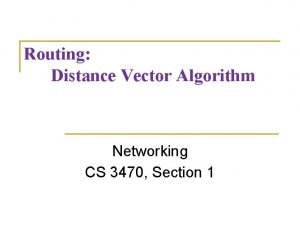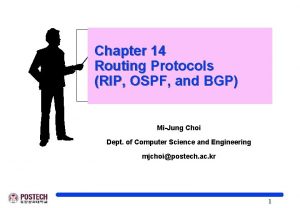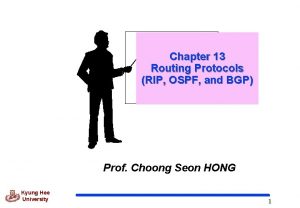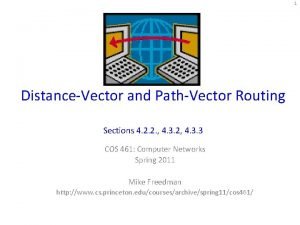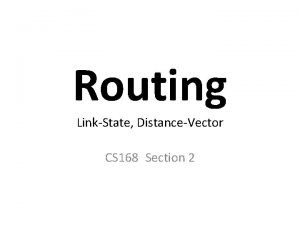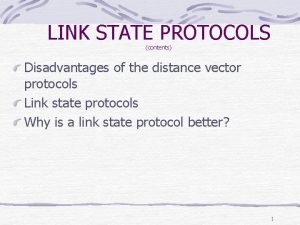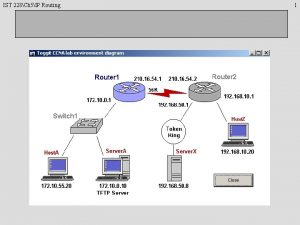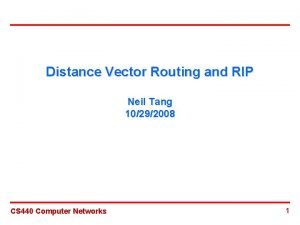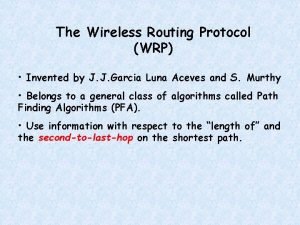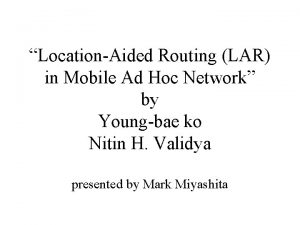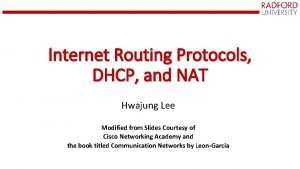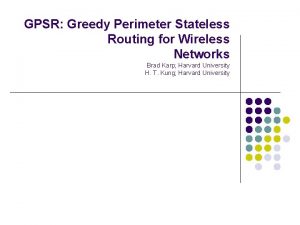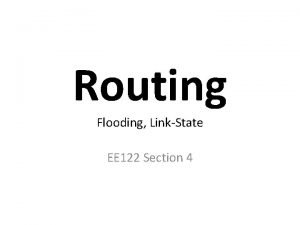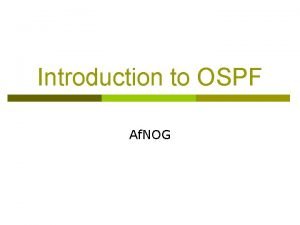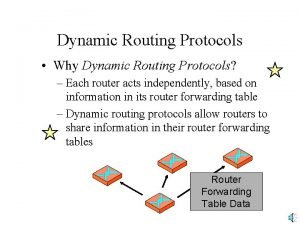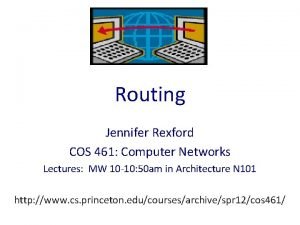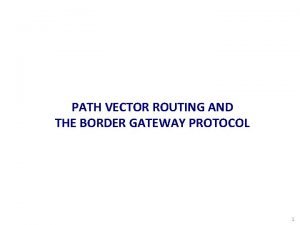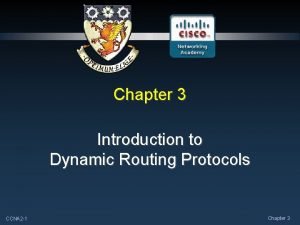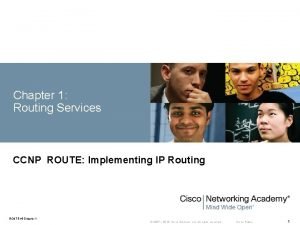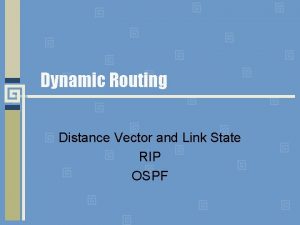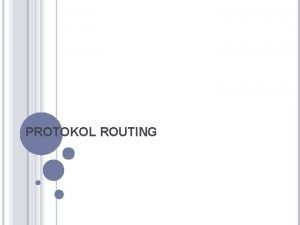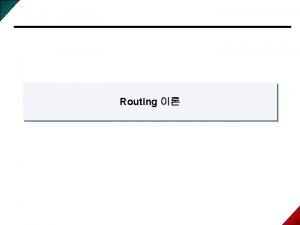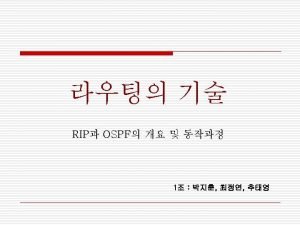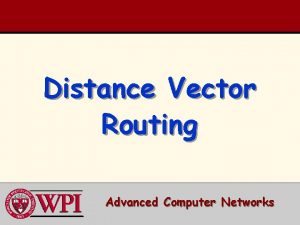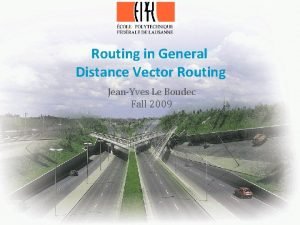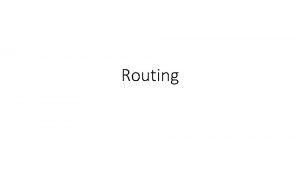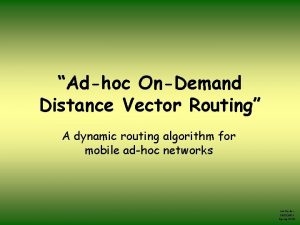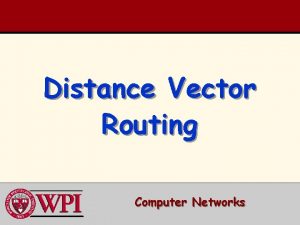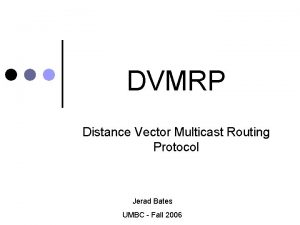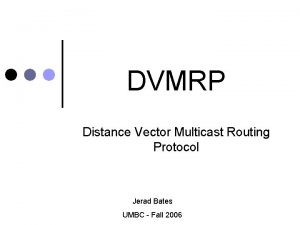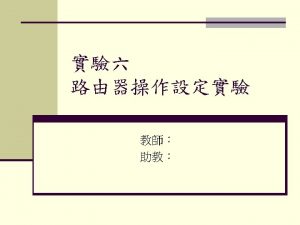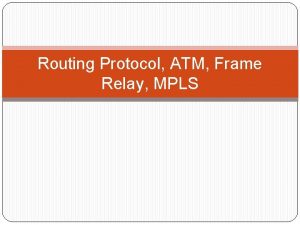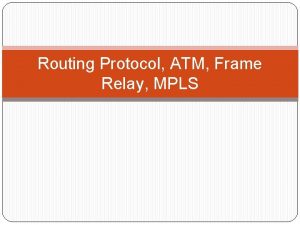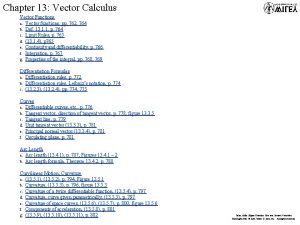Distance vector routing protocol This concept gives a





























- Slides: 29

Distance vector routing protocol This concept gives a brief idea about the one type of forwarding protocol followed in routing. Subject: Communication Networks/ Computer networks Authors Parul Goradia Mentor Prof. Saravanan

Learning Objectives After interacting with this Learning Object, the learner will be able to: • • Explain forwarding. Explain distance vector routing protocol. Complete the routing table of a given node. Identify the forwarding routes from one node to another node.

1 2 Master Layout 1: B D A E 3 4 5 C F

1 2 3 4 5 Step 1: T 1: Analogy of postal office

1 Master Layout 2: routing network 2 3 Nodes 4 5

1 2 3 4 5 Master Layout 2: routing tables

1 2 3 4 5 Step 2: T 1: Forwarding

Master Layout 3: forwarding interactivity 1 2 Fig 2: 3 4 5

1 2 3 4 5 Step 3: T 1: Forwarding interactivity

1 2 3 4 5 Master Layout 4:

1 2 3 4 5 Step 4: T 1: Forwarding

1 2 3 4 5 Master Layout 5:

1 2 3 4 5 Master Layout 6:

1 Master Layout 7: 2 This entry after B sends packet 3 4 5

1 Master Layout 8: 2 3 4 5 This entry after B sends packet

1 2 3 4 5 Step 5: T 1: Forwarding

1 2 3 4 5 Step 6: T 1: Forwarding

1 2 3 4 5 Step 7: T 1: Forwarding

1 2 3 4 5 Step 8: T 1: Forwarding

1 Master Layout 9: 2 FIG 1 FIG 2 FIG 3 3 4 FIG 4 5 FIG 5

1 Step 9: T 1: Distance vector routing protocol interactivity 2 2 2 3 5 3 4 5 1 2

1 Step 10: T 1: Distance vector routing protocol interactivity Vertices 2 3 4 5 Cost of this links (value between 1 and 10) ok Done

1 2 3 4 5 Concepts: • RN; Reachable node: All the destinations/ nodes that can be reached by a node. • NH; Next hop: The next hop, or gateway, is the address of the next station to which the packet is to be sent on the way to its final destination • RC; Routing Cost: The cost or metric of the path through which the packet is to be sent • Routing table: • When a node needs to send data to another node on a network, it must know where to send it, first. If the node cannot directly connect to the destination node, it has to send it via other nodes along a proper route to the destination node. • Most nodes do not try to figure out which route(s) might work; instead, a node will send an IP packet to a gateway in the LAN, which then decides how to route the "package" of data to the correct destination. Each gateway will need to keep track of which way to deliver various packages of data, and for this it uses a Routing Table. • A routing table is a database which keeps track of paths, like a map, and allows the gateway to provide this information to the node requesting the information.

1 2 3 4 5 Concepts: Route: As the size of a network grows, many pairs of nodes will not be directly connected to each other and will depend on intermediate nodes to relay packets between them. A sequence of relay nodes which transfer information between a source-destination node pair is called a route. Routing: Routing is the process of constructing the routing tables in a network such that packets ex-changed between pairs of nodes take paths which have lowest cost among all available paths. Distance vector routing protocol: The main idea behind DVRP is that each node constructs a vector containing the shortest distances from itself to all the nodes it knows are reachable from it and distributes this vector to its immediate neighboring nodes. The assumption is that a node knows which nodes are its immediate neighbors and also the costs to these neighboring nodes. The neighboring nodes upon receiving the distance vector update their own distance vectors if they find shorter routes to nodes which are reachable from them or if they find that new nodes which are not present in their distance vector.

1 2 3 4 5 Questionnaire 1. Consider the six-node communication network shown in the below figure. (a) List all routes from node S to node D. [2 points] (b) The number alongside a link indicates the packet delay incurred on that link in seconds. Taking the routing cost of a route to be the sum of the delays of the links which constitute the route, write down the minimumdelay routing tables for the nodes S, R 1, R 2 and R 3 in the format shown in the table below.

1 2 3 4 5 Questionnaire- Answer 1. Consider the six-node communication network shown in the below figure. (a) List all routes from node S to node D. [2 points]

1 2 3 4 5 Questionnaire- Answer (b) The number alongside a link indicates the packet delay incurred on that link in seconds. Taking the routing cost of a route to be the sum of the delays of the links which constitute the route, write down the minimumdelay routing tables for the nodes S, R 1, R 2 and R 3 in the format shown in the table below.

Links for further reading Reference websites: Books: Computer Networks – Andrew S. Tanenbaum fourth edition Communication networks – Leon-Garcia and Widijaja second edition Research papers:

Summary • • The transfer of packet from one node to the other is known a forwarding. • Routing is the process of constructing the routing tables in a network such that packets ex-changed between pairs of nodes take paths which have lowest cost among all available paths. There are two main classes of routing protocols: • Distance vector routing protocol and • Link state routing protocols. • Distance vector routing protocol: In this protocol each node constructs a vector containing the shortest distances from itself to all the nodes it knows are reachable from it and distributes this vector to its immediate neighboring nodes. • The assumption is that a node knows which nodes are its immediate neighbors and also the costs to these neighboring nodes. • The neighboring nodes upon receiving the distance vector update their own distance vectors if they find shorter routes to nodes which are reachable from them or if they find that new nodes which are not present in their distance vector. • Each node sends its distance vector to its neighbors periodically resulting in a periodic update even when there are no changes in its routing table. • When a change occurs in a node’s routing table it immediately sends its new distance vector resulting in a triggered update. • The periodic update is useful in identifying a node failure which can be characterized by the absence of the periodic update message in the last few update cycles.
 Distance vector routing example
Distance vector routing example Distance-vector routing
Distance-vector routing Rip ospf bgp
Rip ospf bgp Distance vector routing algorithm
Distance vector routing algorithm Cs
Cs Advantages and disadvantages of distance vector routing
Advantages and disadvantages of distance vector routing Distance vector routing
Distance vector routing Distance vector
Distance vector Hydrologic storage routing
Hydrologic storage routing Mark tinka
Mark tinka Continuity equation hydrology
Continuity equation hydrology Power routing in vlsi
Power routing in vlsi Wrp protocol
Wrp protocol Lar routing protocol
Lar routing protocol Enhanced interior gateway routing protocol
Enhanced interior gateway routing protocol Dhcp routing protocol
Dhcp routing protocol What is gpsr
What is gpsr Link state routing protocol
Link state routing protocol Ospf routing protocol
Ospf routing protocol Distance vector count to infinity
Distance vector count to infinity Ospf routing protocol
Ospf routing protocol Path vector routing
Path vector routing Bgp path vector
Bgp path vector Routing protocols administrative distance
Routing protocols administrative distance Bgp administrative distance
Bgp administrative distance Line segment geometry
Line segment geometry Vector unitario
Vector unitario Resolution of vectors
Resolution of vectors Define position vector
Define position vector Distance vector vs link state
Distance vector vs link state
